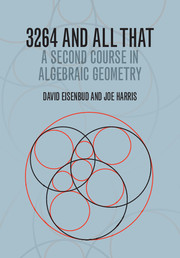Book contents
- Frontmatter
- Contents
- Preface
- Chapter 0 Introduction
- Chapter 1 Introducing the Chow ring
- Chapter 2 First examples
- Chapter 3 Introduction to Grassmannians and lines in ℙ3
- Chapter 4 Grassmannians in general
- Chapter 5 Chern classes
- Chapter 6 Lines on hypersurfaces
- Chapter 7 Singular elements of linear series
- Chapter 8 Compactifying parameter spaces
- Chapter 9 Projective bundles and their Chow rings
- Chapter 10 Segre classes and varieties of linear spaces
- Chapter 11 Contact problems
- Chapter 12 Porteous' formula
- Chapter 13 Excess intersections and the Chow ring of a blow-up
- Chapter 14 The Grothendieck Riemann–Roch theorem
- Appendix A The moving lemma
- Appendix B Direct images, cohomology and base change
- Appendix C Topology of algebraic varieties
- Appendix D Maps from curves to projective space
- References
- Index
Chapter 11 - Contact problems
Published online by Cambridge University Press: 05 March 2016
- Frontmatter
- Contents
- Preface
- Chapter 0 Introduction
- Chapter 1 Introducing the Chow ring
- Chapter 2 First examples
- Chapter 3 Introduction to Grassmannians and lines in ℙ3
- Chapter 4 Grassmannians in general
- Chapter 5 Chern classes
- Chapter 6 Lines on hypersurfaces
- Chapter 7 Singular elements of linear series
- Chapter 8 Compactifying parameter spaces
- Chapter 9 Projective bundles and their Chow rings
- Chapter 10 Segre classes and varieties of linear spaces
- Chapter 11 Contact problems
- Chapter 12 Porteous' formula
- Chapter 13 Excess intersections and the Chow ring of a blow-up
- Chapter 14 The Grothendieck Riemann–Roch theorem
- Appendix A The moving lemma
- Appendix B Direct images, cohomology and base change
- Appendix C Topology of algebraic varieties
- Appendix D Maps from curves to projective space
- References
- Index
Summary
Keynote Questions
(a) Given a general quintic surface S ⊂ ℙ3, how many lines L ⊂ ℙ3 meet S in only one point? (Answer on page 391.)
(b) If {Ct = V(t0F + t1G + t2H) ⊂ ℙ2} is a general net of cubic plane curves, how many of the curves Ct will have cusps? (Answer on page 416.)
(c) If {Ct = V(t0F + t1G) ⊂ ℙ2} is a general pencil of quartic plane curves, how many of the curves Ct will have hyperflexes? (Answer on page 405.)
(d) If {Ct} is again a general pencil of quartic plane curves, what are the degree and genus of the curve traced out by flexes of members of the pencil? (Answer in Section 11.3.2.)
Problems such as these, dealing with orders of contact of varieties with linear spaces, are known as contact problems. Their solution can often be reduced to the computation of the Chern classes of associated bundles. The most important of the bundles involved is a relative version of the bundle of principal parts introduced in Chapter 7 and described by Theorem 7.2. We will begin with an illustration showing how these arise.
One point of terminology: We define the order of contact of a curve C on a smooth variety X with a Cartier divisor D ⊂ X at p ∈ C to be the length of the component of the scheme of intersection C ⋂ D supported at p, or (equivalently) if is the normalization, the sum of the orders of vanishing of the defining equation of D at points of lying over p. If p is an isolated point of C ⋂ D, this is the same as the intersection multiplicity mp(C. D), and we will use this to denote the order of contact; however, we will also adopt the convention that if C ⊂ D then the order of contact is ∞, so that the condition mp(C. D) ≥ m is a closed condition on C, D and p.
Finally, we reiterate our standing hypothesis that our ground field has characteristic 0. As with most questions involving derivatives, the content of this chapter is much more complicated in characteristic p, and many of the results derived here are false in that setting.
- Type
- Chapter
- Information
- 3264 and All ThatA Second Course in Algebraic Geometry, pp. 389 - 425Publisher: Cambridge University PressPrint publication year: 2016

